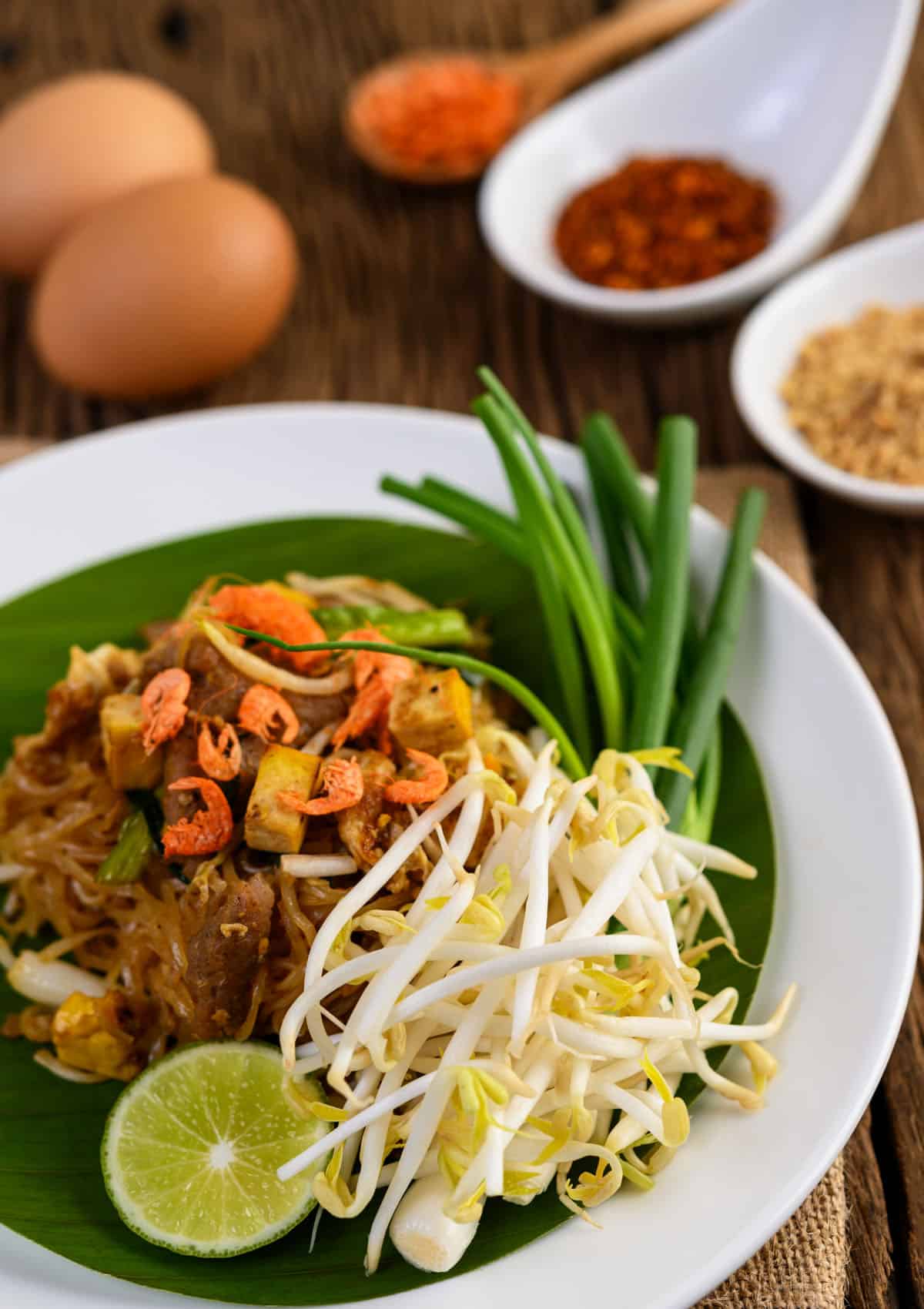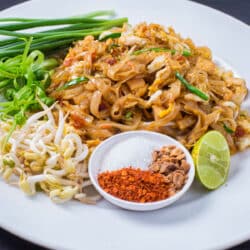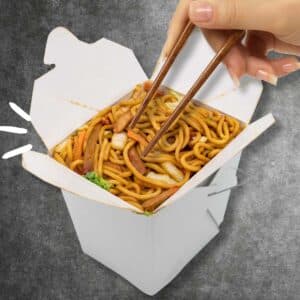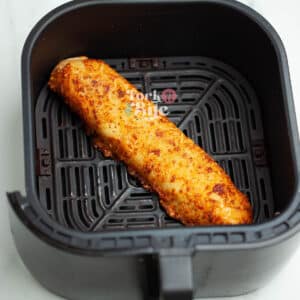If you're anything like me, you love Pad Thai. The combination of salty, sweet, and sour is irresistible. And leftovers are the best part. But reheating Pad Thai can be tricky. Overcooking the noodles will cause them to become mushy. But they won't be warm enough if you don't cook them long enough.
Here's my foolproof method for reheating Pad Thai so it's just as delicious as when you first made it.

Reheating Pad Thai: a Test
I wanted to test the best way to reheat Pad Thai, so I experimented with three popular methods: stove, microwave, and oven. After trying each scenario, the stove was the best in taste and texture - it produced a fresh-tasting dish almost identical to when it had been freshly cooked.
So, what happened the next day?
Well, the stove was by far the best method. It gave a more consistent texture and tasted almost like it had when I ordered it. The microwave was okay, too - if you're in a rush, this is probably your best option - but the results could have been better with the stove. Finally, the oven worked well for reheating larger batches of Pad Thai but lacked the same freshness or texture as with the stove.
Now that I've tried these methods, I can confidently say that if you want to enjoy deliciously freshly-reheated Pad Thai, using the stove is your best bet! Thanks to my experiment, I can now relish my favorite dish whenever possible.
Read:
How to reheat Pad Thai
I've never been a huge fan of leftovers, but there are exceptions to every rule. But with some know-how, restoring your leftovers to their former glory is possible. Pad Thai is one of those dishes I enjoy eating the next day, cold or reheated. The key is in the preparation, considering that reheating rice noodles can be a delicate process.
Here are some tips for reheating Pad Thai like a pro without ruining its flavor.
How to reheat Pad Thai on the stove.
Step 1
Microwave your Pad Thai noodles for five seconds before adding them to the pan. Five seconds isn't much in the grand scheme of things, but it's just the right amount of time to help you get that perfect reheat. Any longer, and you'll end up with soggy noodles.
Why microwave the Pad Thai noodles?
It's simple: the microwave softens them. It is much easier to separate the noodles and get them evenly heated in the pan. If you skip this critical step, your pad Thai will have mushy and unheated sections. Don't let that happen - give your pad Thai a quick nuke before reheating on the stove. You'll be glad you did!
Read:
Step 2
Once microwaved, use a fork to separate the noodles gently so it's easier to stir and evenly distribute without having some parts more cooked than others.
Step 3
Heat a wok or skillet over medium heat and add 1 or 2 tablespoon of oil. Peanut oil is a great choice as it has an incredibly high smoking point and won't burn. However, other oils like vegetables and canola will also work. Heating the skillet ensures that the oil will be hot enough to heat the noodles quickly.
Step 4
After the oil shimmers, add the slightly microwaved Pad Thai noodles to the pan and pour a splash of water ( 1 or 2 tbsp, depends how many noodles you have) or extra Pad Thai sauce. This helps prevent the noodles from sticking to the bottom of the pan and also adds some moisture that will help keep them moist.
Why add water to Pad Thai noodles?
Rehydrating Pad Thai noodles with extra water can help them regain their shape after drying out in the refrigerator. Having said that, don't go overboard; otherwise, your pad Thai will end up watery.
Making extra sauce is a better option, rather than using water. That way, you moisten the noodles and get a burst of flavor.
When reheating Pad Thai, it's important to avoid overcrowding the pan. If too many noodles are in one spot, they can cook unevenly and become mushy.
Also, make sure to cook the noodles no longer than necessary. Overcooked Pad Thai can become a gooey mess, so keep an eye on it and remove it from the heat as soon as it's warmed.
Step 5
Avoid stirring the noodles if possible. Instead, try flipping them over to cook both sides evenly. Distribute the heat evenly over the pan for one to two minutes or your preferred temperature. This will help keep the noodles' texture intact and piping hot throughout.
Why does it work?
Stirring the noodles while reheating them on the stove can cause them to break apart and become mushy. It's best to avoid stirring them if possible to maintain their original flavor and texture. This will result in Pad Thai, which is less flavorful or has a less attractive texture.
Step 6
Add some of your favorite vegetables to the pan, such as bell peppers, carrots, and peas (although they are optional). This will help to add flavor and color to the Pad Thai. Stirring everything very gently before taking it off the heat will ensure that everything is evenly cooked and heated.
Step 7
Serve your reheated Pad Thai noodles with freshly squeezed lime juice for extra zing, and garnish with your favorite herbs such as cilantro, Thai basil, or mint.
What's the verdict?
I'm sold on skillet-reheating pad thai. It's the best way to reheat this flavorful dish since it retains all the great flavor you get from eating it fresh. Plus, the high heat helps maintain the texture of the noodles and keeps them from becoming too mushy. All in all, a win-win!
The only downside is that your stovetop will take some extra cleaning, but it's worth it for the deliciousness of a skillet-reheated pad thai meal!
Read:
How to reheat Pad Thai in the microwave?
I'm not sure about you, but I love Pad Thai. It is my favorite Thai dish. But sometimes, I only eat some of it and have to reheat it the next day. So, how do you reheat Pad Thai in the microwave without ruining it?
Fortunately, the process is straightforward. You must use your microwave on 50% power and heat the Pad Thai in short intervals. Watch the dish closely so that you avoid accidentally overcooking or burning it. If you take these precautions, your Pad Thai will be just as delicious as when you first made it.
How to reheat Pad Thai in the microwave so the middle isn't sad and cold?
Step 1 Get creative!
Before you pop them in the microwave, scoop the leftover rice noodles into a circular-shaped plate and arrange them into a doughnut shape (like a ring). Doing this helps heat to conduct evenly, ensuring that your noodles get heated up nicely rather than having cold spots where the heat doesn't reach.
Here's another trick:
Instead of adding your Pad Thai to one large dish and zapping it, try dividing it into two or three smaller plates. This way, the microwaves can penetrate all of the noodles quickly and evenly. You'll avoid those nasty, cold spots that no one likes!
Step 2 Add extra moisture.
Give your Pad Thai a splash of water just before reheating (about 1 tbsp). This will create steam, which helps add some moisture back into the meal, eliminating any dryness that may have been caused by its time in the fridge. It also prevents it from becoming tough and chewy as it would if you were to reheat it without water.
Step 3 Cover it with a damp paper towel.
You want to keep all the precious moisture you just added! To prevent the water from evaporating in the process, cover your Pad Thai with a damp paper towel before reheating. Be sure to use one that isn't dripping wet, as too much water could make the noodles soggy instead of perfectly cooked.
The damp paper towel helps retain the moisture and traps the heat inside so the noodles get an even zap while keeping them from drying out. It also prevents them from splattering all over your microwave, making cleanup a breeze.
Another option:
Put a lid on your Pad Thai, yet leave room for the steam to escape, or your noodles will be soggy. You can also use plastic cling wrap pierced with a few holes if you don't have a lid to match. This helps to keep the noodles moist as they heat up and ensures that all areas of the dish are heated evenly.
Step 4 Heat in short bursts.
Set your microwave to 50% power, and start heating your noodles for 30 seconds. After each interval, give them a gentle stir with chopsticks or a fork to ensure the heat is evenly distributed. Keep heating at 30-second intervals until you've achieved a piping-hot dish. You'll know it's done when it's steaming and fragrant.
Why heat Pad Thai on 50% power?
Reheating Pad Thai in the microwave at 50% power level helps to retain its flavor and texture. It ensures that the Pad Thai is heated evenly without any burnt spots so you can enjoy a delicious meal every time. And most importantly, the lower power setting protects delicate ingredients from getting overcooked and helps maintain the freshness of vegetables and proteins for a healthier dish.
Step 5 Finish with flavor.
After reheating your Pad Thai, add a few fresh herbs and spices sprinkles to give it an extra punch of flavor. A bit of lime juice or fish sauce can also bring out the natural sweetness in the noodles.
Microwaved Pad Thai: What's the verdict?
There are better ways to go about it; however, if you're pressed for time or have limited cooking options, this can work in a pinch. The tradeoff is that you may lose some of the flavor and texture of your Pad Thai dish. For an optimal experience, take the extra time to heat it on the stove or in the oven. If you do choose to use the microwave, make sure you heat it slowly and evenly. This will help preserve some of the flavor and texture of your Pad Thai dish so that you can still enjoy it!
Read:
How to reheat Pad Thai in the oven.
Reheating Pad Thai in the oven sounds unlikely, yet it is a handy trick for large batches. All you need is some tin foil and about 5 to 6 minutes in the oven.
Here's how to do it:
Step 1 Preheat the oven to 350°F
Preheating helps the oven reach the desired temperature quickly so that food can be cooked evenly.
Step 2 Microwave the Pad Thai noodles for 5 seconds.
Taking the leftover Pad Thai out of the fridge will likely be very clumpy, making it tricky to spread out without breaking them. This process helps to break down the bonds between the noodles due to the cold temperatures they were stored in, thus allowing them to be spread out easily on the baking tray. This helps create an even layer of Pad Thai that will cook evenly in the oven.
Step 3 Lay the Pad Thai on a baking sheet lined with parchment paper or lightly greased aluminum foil.
You can use cooking oil, butter, or non-stick cooking spray. Gently spread out the noodles, ensuring they are in an even layer and not clumped together.
Step 4 Add extra moisture.
Sprinkle a few drops of water or broth on top of the Pad Thai to help create steam while the Pad Thai is cooking in the oven, preventing it from drying. This is crucial because it will help keep the noodles tender and moist.
Step 5 Wrap the tray in foil.
This helps to contain the heat and moisture while cooking, creating a steamy environment that will help keep the Pad Thai moist. The foil also helps to keep the Pad Thai from drying out and prevents it from burning.
Step 6 Bake for 5 to 10 minutes.
The exact baking time will depend on the size of your baking dish and the amount of Pad Thai you intend to reheat. After 5 minutes, check if the Pad Thai is heated through. If not, bake for 5 minutes or until the desired temperature is reached. Keep an eye on the noodles during this process to avoid overcooking them.
Step 7 Serve immediately.
Once the Pad Thai is heated through, it's time to serve! From a quick snack to a full meal, reheated Pad Thai can be enjoyed anytime! Enjoy your freshly-reheated Pad Thai with your favorite toppings and condiments.
What's the verdict when reheating Pad Thai in the oven?
Reheating Pad Thai in the oven can be effective, but there are better ways to do it. The result is a mixed bag. It's better to find ways to preserve its flavor and texture, like using a pan or wok over medium-low heat.
The biggest downside is that you'll lose some of the flavor and texture of the dish since its ingredients will change as they're heated up. Additionally, the noodles can become soggy, and the sauce will likely evaporate.
Read:
The shelf life of leftover Pad Thai.
The shelf life of leftover foods is not nearly as long as you would like. The deliciousness of Pad Thai is no exception. The best practice is to try and eat all your leftovers within three days or risk them going bad – an unfortunate fate that no one wants for their beloved dish. The good news is that a savory meal like Pad Thai makes for some great leftover lunches or dinners the next day! The key is to ensure you're storing it in an airtight container and keeping it in a refrigerator. That way, your leftovers will stay as fresh as possible for that final meal. Who knows, you might even like it better, cold!
How to store leftover Pad Thai: the proper way.
Pad Thai can last up to three days if stored properly; however, you'll need to watch out for the heavy sauces. They tend to make it soggy and give it a less-than-desirable texture after only a few hours - so enjoy fresh or miss out on that fantastic flavor!
Follow these steps when storing Pad Thai in the fridge:
Step 1 Put it into an airtight container.
Always store leftover Pad Thai in an airtight container. This will prevent odors from getting into your food and help keep it fresh.
Step 2 Separate the sauce from the noodles.
The sauces that come with Pad Thai can make them soggy if stored together too long, so it's best to separate them. Toppings like crushed peanuts and cilantro should also be in a separate container as they will absorb moisture and can wilt quickly and lose flavor if stored with the noodles.
Step 3 Add a layer of oil.
Adding a light layer of oil will help keep the noodles from sticking together and becoming a solid mass when reheating. This can be done by pouring a small amount of neutral-flavored cooking oil over the top before putting it on the lid.
Step 4 Leave a little space at the top of each container.
Leaving some airspace between the lid and your Pad Thai helps prevent moisture from forming on your food. You don't want any nasty condensation to ruin your meal!
Step 5 Label the container with the date.
Labeling your containers helps track when you made or stored the Pad Thai. This will help prevent food waste and ensure your leftovers don't go to waste.
Step 6 Place the container in the refrigerator.
Once your Pad Thai is safely stored in an airtight container, pop it into the fridge. This will help prevent bacteria from growing on your food, as well as slow down spoilage. Make sure you store it at a temperature below 40 degrees Fahrenheit.
Step 7 Eat within three days.
Eating your Pad Thai the same day you make it is best, but if you have leftovers, they'll last up to three days in the refrigerator. After that, the Pad Thai will spoil and should be discarded. Make sure to check for any signs of spoilage before reheating and eating.
Step 8 Reheat with care.
When you are ready to enjoy your Pad Thai again, heat it slowly over low heat until it's hot throughout – be careful not to overcook it, as it can become rubbery and unappetizing. It's also important to flip the noodles occasionally to ensure they don't burn and stick together. (You can check the instructions mentioned above on how to reheat the Pad Thai).
Can you freeze Pad Thai?
Pad Thai leftovers can be frozen. While this is possible, I'm not a fan of it because the noodles and vegetables will lose their texture when reheated. Your dish will become a sloppy mess with much of its flavor gone. It's still edible but not very appetizing.
The easiest way to freeze Pad Thai is to seal it in a freezer-safe bag and press out any air. If you freeze your Pad Thai this way, you will be less likely to experience freezer burn, but you should still aim to eat your frozen Pad Thai within a month for the best results.
How to Reheat Pad Thai
Pin RecipeIngredients:
- leftover Pad Thai
Instructions:
How to reheat pad thai on the stove:
- Microwave your Pad Thai noodles for five seconds before adding them to the pan. Five seconds isn’t much in the grand scheme of things, but it’s just the right amount of time to help you get that perfect reheat. Any longer, and you’ll end up with soggy noodles.
- Once microwaved, use a fork to separate the noodles gently so it’s easier to stir and evenly distribute without having some parts more cooked than others.
- Heat a wok or skillet over medium heat and add 1 or 2 tablespoon of oil. Peanut oil is a great choice as it has an incredibly high smoking point and won’t burn. However, other oils like vegetables and canola will also work. Heating the skillet ensures that the oil will be hot enough to heat the noodles quickly.
- After the oil shimmers, add the slightly microwaved Pad Thai noodles to the pan and pour a splash of water ( 1 or 2 tbsp, depends how many noodles you have) or extra Pad Thai sauce. This helps prevent the noodles from sticking to the bottom of the pan and also adds some moisture that will help keep them moist.
- Avoid stirring the noodles if possible. Instead, try flipping them over to cook both sides evenly. Distribute the heat evenly over the pan for one to two minutes or your preferred temperature. This will help keep the noodles’ texture intact and piping hot throughout.
- Add some of your favorite vegetables to the pan, such as bell peppers, carrots, and peas (although they are optional). This will help to add flavor and color to the Pad Thai. Stirring everything very gently before taking it off the heat will ensure that everything is evenly cooked and heated.
- Serve your reheated Pad Thai noodles with freshly squeezed lime juice for extra zing, and garnish with your favorite herbs such as cilantro, Thai basil, or mint.
How to reheat pad thai in the microwave:
- Be creative.Before you pop them in the microwave, scoop the leftover rice noodles into a circular-shaped plate and arrange them into a doughnut shape (like a ring). Doing this helps heat to conduct evenly, ensuring that your noodles get heated up nicely rather than having cold spots where the heat doesn’t reach.
- Add extra moisture.Give your Pad Thai a splash of water just before reheating (about 1 tbsp). This will create steam, which helps add some moisture back into the meal, eliminating any dryness that may have been caused by its time in the fridge. It also prevents it from becoming tough and chewy as it would if you were to reheat it without water.
- Cover it with a damp paper towel.You want to keep all the precious moisture you just added! To prevent the water from evaporating in the process, cover your Pad Thai with a damp paper towel before reheating. Be sure to use one that isn’t dripping wet, as too much water could make the noodles soggy instead of perfectly cooked.
- Heat in short bursts.Set your microwave to 50% power, and start heating your noodles for 30 seconds. After each interval, give them a gentle stir with chopsticks or a fork to ensure the heat is evenly distributed. Keep heating at 30-second intervals until you’ve achieved a piping-hot dish. You’ll know it’s done when it’s steaming and fragrant.
- Finish with flavor.After reheating your Pad Thai, add a few fresh herbs and spices sprinkles to give it an extra punch of flavor. A bit of lime juice or fish sauce can also bring out the natural sweetness in the noodles.
How to reheat pad thai in the oven:
- Preheat the oven to 350°F. Preheating helps the oven reach the desired temperature quickly so that food can be cooked evenly.
- Microwave the pad thai noodles for 5 seconds.Taking the leftover Pad Thai out of the fridge will likely be very clumpy, making it tricky to spread out without breaking them. This process helps to break down the bonds between the noodles due to the cold temperatures they were stored in, thus allowing them to be spread out easily on the baking tray. This helps create an even layer of Pad Thai that will cook evenly in the oven.
- Lay the pad thai on a baking sheet lined with parchment paper or lightly greased aluminum foil.You can use cooking oil, butter, or non-stick cooking spray. Gently spread out the noodles, ensuring they are in an even layer and not clumped together.
- Wrap the tray in foil.This helps to contain the heat and moisture while cooking, creating a steamy environment that will help keep the Pad Thai moist. The foil also helps to keep the Pad Thai from drying out and prevents it from burning.
- Bake for 5 to 10 minutes.The exact baking time will depend on the size of your baking dish and the amount of Pad Thai you intend to reheat. After 5 minutes, check if the Pad Thai is heated through. If not, bake for 5 minutes or until the desired temperature is reached. Keep an eye on the noodles during this process to avoid overcooking them.
- Serve immediately.Once the Pad Thai is heated through, it’s time to serve! From a quick snack to a full meal, reheated Pad Thai can be enjoyed anytime! Enjoy your freshly-reheated Pad Thai with your favorite toppings and condiments.
Notes:
The shelf life of leftover Pad Thai.
The shelf life of leftover foods is not nearly as long as you would like. The deliciousness of Pad Thai is no exception. The best practice is to try and eat all your leftovers within three days or risk them going bad – an unfortunate fate that no one wants for their beloved dish. The good news is that a savory meal like Pad Thai makes for some great leftover lunches or dinners the next day! The key is to ensure you're storing it in an airtight container and keeping it in a refrigerator. That way, your leftovers will stay as fresh as possible for that final meal. Who knows, you might even like it better, cold!Please note that all nutrition information are just estimates. Values will vary among brands, so we encourage you to calculate these on your own for most accurate results.





